Few technical terms to be familiar within respect of VNR Madhur cultivation
“Pollination– Hand pollination–Self-pollination–Crosspollination”
Pollination –
Custard Apple is entomophily i.e., pollinated by insects. It is profoundly pollinated by Nitidulid beetle. This insect is however very sensitive to various environmental stresses like human interference, weather conditions, chemical sprays in field or surroundings. etc. It is found that many orchards do not bear fruits regularly due to lack of insect pollination.

What is Pollination?
It is a process in which the pollen from male anther gets transferred to stigma of female flowers with the help of pollinating agents.
What are pollinating agents?
The medium which helps or enhances the chances of pollination are agents of pollination like– insects, birds, animals, wind, water and humans.
What is self-pollination?
When a female flower is pollinated from male pollens of the same flower or from the flower of same plant then it is termed as “self-pollination”.
What is cross-pollination?
When a female flower is pollinated from male pollens of different flower from different plant of same variety/species then it is termed as “cross-pollination”.
What is hand pollination?
When the process of transferring pollen involves any implement with human intervention than it is termed as hand pollination.
How is hand pollination beneficial?
Hand pollination enhances the chance of best quality fruit set. As, Sithaphal is pollinated by insects especially “Nitidulid beetle” of which the chances of good quality fruits set are low. As the life cycle of insects varies according to changing weather conditions hence no. of fruits varies from year to year.
How is hand pollination done?
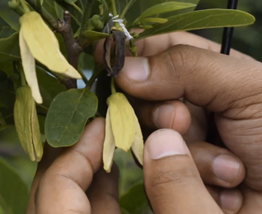
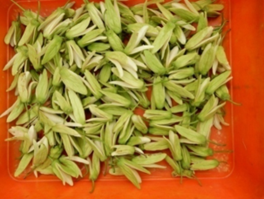
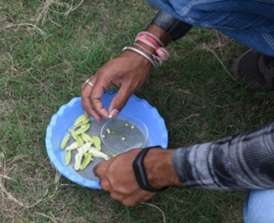
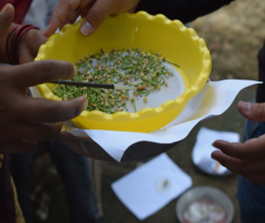
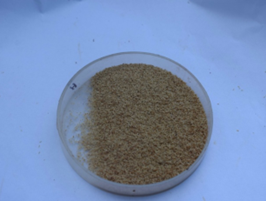
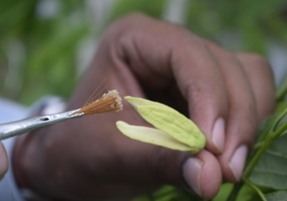
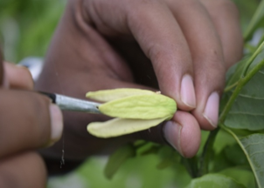
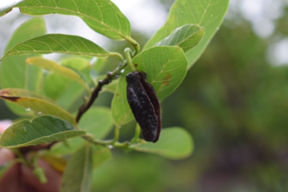
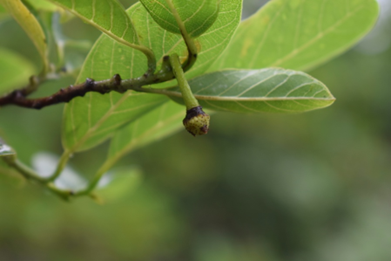
Step 1- Plucking flowers for the pollen collection, Step 2- Storage of flower, Step 3
- Removing of petal, Step 4- Detached the pollen from flower, Step 5 – Placed the
collected pollen, Step 6 – Rub the pollen in flower by paint brush, 7- Fruit set after
pollination
YouTube link- https://www.youtube.com/watch?v=o-ubTXjsxe4
Pollen collection–
Selection of healthy flowers for pollen collection–
- Select healthy flowers only
- Collect the flowers and store overnight at normal room temperature.
- Pollen is ready to pollinate when the color of pollen becomes creamiest white.
- If the pollen is dark brown in color, then it is considered as non-viable pollen.
Time of pollen collection – Time around 5pm to 7pm is the best time for pollen
collection.
Why pollen collection at evening time?
It is because of pollen dehiscence starts at evening time.
Storage of collected pollen– Store the collected pollen in normal room temperature by covering with cloth to maintain the moisture within the flowers.
- How to do hand Pollination?
- Selection of flowers for hand pollination
- Place the flower collected into the plastic sieve and rub the pollen part gently in the sieve in order to detach pollen from the flower.
- The time of removal of pollen is from 5 am to 8 am in the morning.
- After removal of pollen part, it is then placed in pollen container and also advised to pollinate the flower at that morning time till 9 am, because the pollen loses its viability.
- Now you need is paint brush, apply in pollen and again gently rub into the flower inside.
- Tagging is most important aspect after pollination to recognize the pollinated flowers.
Different method of tagging –
1.Tagging should be done with proper tag with date
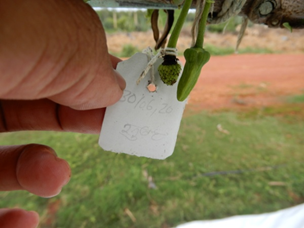
2.Tagging done by breaking the petal
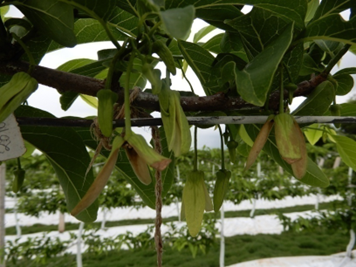
- Time frame for pollination to fruit set – 5 days
- Time frame for pollination to harvest –3-4 months
- Pollination Per day per skilled labor –
300 Pollinizer flower collection in evening time
100 flower pollination in morning from 7-9 am.
- Pollination Per day per unskilled/new labor –
150 pollinizer flower collection in evening time
40-50 flower pollination in morning from 7-9 am.








